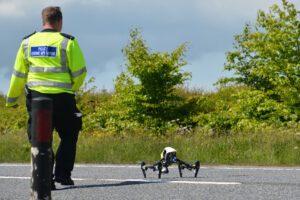
Is a Certificate of Authorization (COA) the right way for your public safety department to operate? Here, Steve Rhode discusses when and why it may be appropriate – or not – to operate under a COA.
The Elusive COA White Whale
Many public safety drone operations decide to fly under a Certificate of Waiver or Authorization (COA) to conduct flight operations for their government operations.
In my experience, many decide to go this route because some salesperson or a friend has said it is the easiest way to conduct operations.
I had a Sheriff’s office tell me why they went to the COA route to self-certify their pilots because they could not pass the Part 107 certificate exam.
Another office told me they went with the COA to avoid paying Part 107 test fees.
Those are not good reasons for flying under a COA. Not even close.
So Let’s Consider the Facts
Flight operations under a COA require the agency to certify the drones are airworthy. But how can they do that if the drones flying today hold no airworthiness certification?
In 2018 I wrote about many of the COA operation pitfalls. Those issues still exist today.
The issues of concern fall into two primary categories:
Category 1
The first is the lack of liability and responsibility for oversight and compliance with the flight rules, awareness the pilot, department, agency, county, and state government are taking on when they operate a COA program. Errors and problems found in a COA program open nearly unlimited liability for that chain of involved parties. The responsibility and obligation to comply with the flight rules do not go away when self-certifying or operating as a Public Aircraft in the NAS.
For example, if you are operating a drone that has a known history of failures, flyaways, incidents, or accidents, you might want to read Your Public Safety Drone May Not Be Safe for Flight and Attorneys Might Just Eat You for Lunch.
Category 2
This second area is the more problematic concern.
I’m not confident that new public safety drone COA operators understand what they are signing up to be responsible for managing.
The COA documents issued to departments provide some guidance, but what they don’t say is often not understood by organizations flying under a COA even though they are responsible for complying with the federal regulations.
Not every flight a department might fly is a Public Aircraft Operation (PAO) which means it’s a civil flight, governed by Part 107, and a COA is not applicable. If the pilot is not a Part 107 certificated pilot, those civil flights will be illegal flights and the operator is likely to be in violation of a number of 14 CFR Part 107 regulations.
Pilots under COAs have personal and full responsibility for all flights they are the Remote Pilot in Command on. They and the Responsible Person tied to the COA can be held personally responsible for all enforcement and civil penalties for their operations. While the COA agency takes over many of the FAA’s responsibilities for overseeing the flight operation, they don’t eliminate all civil regulations and don’t excuse non-compliance.
For example, CFR 91.3 and 91.13 are the big gotchas that will nail every pilot if an issue, incident, or accident escalates
But that isn’t even the primary concern. It still seems nearly impossible for an inexperienced flight operation to engage in a program that meets the requirements of what is expected of them.
Larger government aviation programs that operate and fly PAO flights have found themselves on the wrong end of FAA actions and NTSB evaluations. In one accident report of a PAO flight, the NTSB said, “Because the airplane was operated as a public aircraft operation, the Department of Interiors (DOI) training program was not subject to the civil aircraft requirements. An NTSB review of the flight training program revealed a general outline with hour requirements. The flight training program did not include curriculums, events, or testing and checking procedures. No written maneuvers and procedures guide, with acceptable performance standards was developed, therefore no standardization existed within the pilot group, and tribal knowledge and experimentation were accepted as part of the organization’s culture. Multiple checklists existed for the airplane, and pilots were allowed to use whichever checklist they preferred. DOI did not/nor were they required to incorporate best practices and industry standards into their training program and airplane operations, and no FAA oversight was required or provided.”
In another, the NTSB found, “The investigation also identified that the Alaska DPS lacked organizational policies and procedures to ensure that operational risk was appropriately managed both before and during the mission. Such policies and procedures include formal pilot weather minimums, preflight risk assessment forms, and secondary assessment by another qualified person trained in helicopter flight operations. These risk management strategies could have encouraged the pilot to take steps to mitigate weather-related risks, decline the mission, or stay on the ground in the helicopter after rescuing the snowmobiler. The investigation also found that the Alaska DPS lacked support for a tactical flight officer program, which led to the unavailability of a trained observer on the day of the accident who could have helped mitigate risk.”
While the NTSB report above mentions helicopters. The FAA views helicopters and drones both as aircraft.
What, Me Worry?
As part of the COA, the department faces what manned pilots call a ramp check; you receive a surprise visit from an FAA representative on the ramp at the airport.
Look at your COA and see if you have similar language to this in yours, “During the time this COA is approved and active, a site safety evaluation/visit may be accomplished to ensure COA compliance.”
Some recent crash investigations of a public entity by the FAA found massive numbers of violations or non-compliant operations in public safety COA programs. It is happening, but nobody wants to raise their hand and talk about being caught by the FAA.